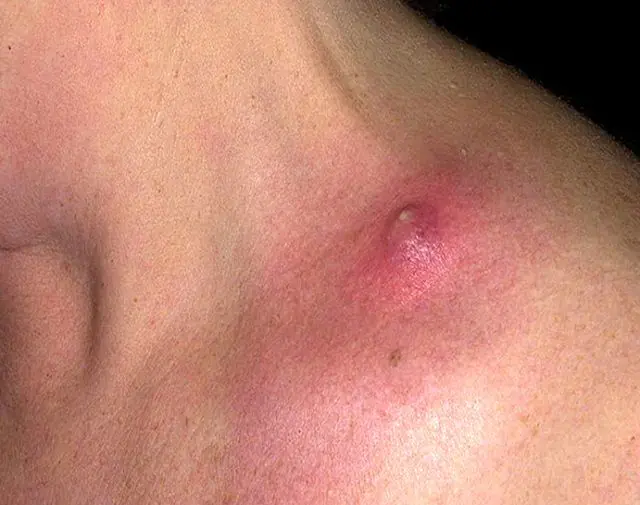- Reasons for appearance
- Stages of development
- Treatment
A purulent boil is an inflammation that affects the hair follicles, sebaceous glands, and nearby connective tissues. In most cases, it is provoked by Staphylococcus aureus, but other types of pyogenic bacteria may also take part in its development. If several purulent foci of inflammation appear on the skin, a diagnosis of furunculosis is made.
Causes of a purulent boil
The cause of this disease is Staphylococcus aureus. On its own, it does not pose a danger to the human body, but when certain conditions are created, it begins to multiply rapidly, which provokes the onset of inflammation.
Factors that cause the appearance of a purulent boil include:
- severe skin contamination;
- neglect of personal hygiene rules;
- microdamage to the skin;
- frequent contact with toxic and chemical substances;
- disruptions in the functioning of the immune system;
- direct skin contact with painful discharge;
- increased sweating;
- disruptions that occur in the hormonal system, which causes a violation of skin protection.
Such factors include poor nutrition, which negatively affects the metabolic process.
Stages of development of a purulent boil
The development of a boil goes through a certain cycle, consisting of three stages:
- Infiltration phase - the skin around the source of inflammation thickens, swelling and redness develop. Soreness also appears.
- Necrosis phase - observed 3–4 days after the onset of inflammation. The root of the boil develops around the inflamed hair follicle. This core can also be called necrotic; it consists of pus and dead tissue. The boil bursts, after which pus and the stem come out.
- Healing phase - gradual healing of the damaged skin begins, this occurs after the pus flows out and the core of the boil is released.
- Read also the article: What to do if the core does not come out of the boil
Treatment of purulent boils: ointments and traditional methods
In the most severe cases, when acute purulent furunculosis is diagnosed, only a doctor can prescribe treatment, especially if there are multiple inflammations on the body. Antibiotics are prescribed, which are selected after tests are taken to determine the sensitivity of staphylococcus to the drug.
Many people do not know how to treat a purulent boil correctly. It is important to remember that the pus needs to be removed first. You can use several tools for this:
- Ointments that draw out pus include ichthyol and Vishnevsky ointment. These drugs are considered not only the most affordable, but also effective. After just a few uses, the pus from the inflammation is completely removed.
- You can use a homemade method such as compresses made from Kalanchoe and aloe, garlic (crushed to a paste), raw beets (grated on a fine grater), vegetable oil and finely chopped onion. You can apply baked onions to the site of inflammation, which also draws out accumulated pus.
After the pus comes out, the patient experiences relief. Then it is imperative to disinfect and calm the area of the breakthrough:
- the wound is thoroughly washed with a large amount of hydrogen peroxide;
- antiseptic ointment is applied - Levomekol is an excellent option;
- at the end, a product is used that accelerates wound healing - for example, calendula ointment.
- It will be useful to read: Ointments against swelling of the face after removal of a boil
You cannot try to squeeze out the boil yourself, otherwise such actions will lead to very unpleasant consequences. There is a high probability that the inflammation will spread to healthy tissue nearby. The greatest danger is posed by ulcers located in the T-zone.
Self-medication is permissible only in cases where it is not possible to see a specialist. You can use means to disinfect the localized area, including ointments that draw pus out. Such procedures will help to slightly alleviate the patient’s condition. But at the first opportunity you should definitely consult a doctor, which will help avoid negative consequences.
- Read an article on the topic: Drugs for the treatment of furunculosis
Video about how a purulent boil is squeezed out on the shin:
[media=https://youtu.be/AW581SICO7Y]



